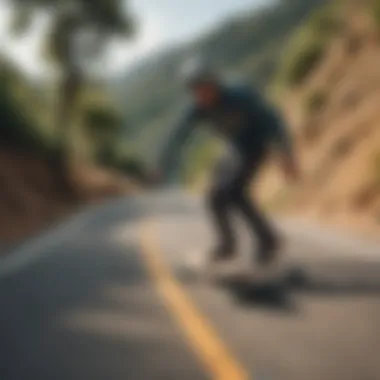Exploring Longboarding: Techniques, Culture, and Community


Intro
Longboarding has evolved from a casual pastime to a vibrant sport, weaving together a diverse array of techniques, styles, and cultures. Understanding longboarding is not just about mastering a few tricks or choosing the right board; it requires an appreciation of the intricate interplay between performance and culture. This article aims to unpack the dynamics of longboarding, examining essential techniques, the evolution of board design, local communities shaped by this sport, and how it interacts with environmental concerns.
As we travel through this landscape, we will look at various facets of longboarding—from the nitty-gritty of riding styles to how the community fosters a uniquely vibrant culture. Whether you’re a seasoned rider seeking a deeper understanding or a newcomer eager to dive in, this comprehensive analysis promises to illuminate the many dimensions of longboarding.
Surf Gear and Equipment
Latest Board Technologies
In the fast-paced world of longboarding, gear evolution is one of the most thrilling aspects. Modern longboards come equipped with innovations that enhance performance and user experience. Most boards are now made from materials like bamboo, fiberglass, and carbon fiber, providing a balance of lightness and durability. The advent of drop-through designs has made it easier to push without losing stability.
When it comes to wheels, the durometer rating, which measures hardness, plays a pivotal role. Softer wheels offer better grip and cushion rough surfaces, while harder wheels excel in speed and slide control. This means that depending on your riding style—whether cruising, downhill racing, or street skating—selecting the right wheel is crucial to optimize your performance.
- Popular Board Types:
- Pintail: Best for cruising.
- Carve Board: Excellent maneuverability.
- Downhill Board: Built for speed.
Essential Accessories for Longboarders
While the board itself is vital, there are other accessories that can significantly enhance the longboarding experience. Appropriate protective gear, such as helmets, knee pads, and wrist guards, is not just for safety; it's a smart way to prolong your longboarding journey.
Moreover, carrying a backpack designed for boarders can make transportation effortless, ensuring tools like skate tools and portable pumps for inflatable boards are on hand. Think about adding:
- Protective Gear:
- Convenient Gear:
- Full-face helmet for advanced riders.
- Lightweight knee and elbow pads.
- Backpack with secure straps.
- Water bottles for hydration.
"Longboarding isn’t just about speed; it’s a delicate dance with physics and balance, much like life itself."
Techniques and Skills
Riding Strategies
Mastering longboarding requires a mixture of skill and awareness. For beginners, learning to balance and push off can be challenging. However, once comfortable, many riders focus on different techniques such as carving, sliding, and transitioning effectively between stances. Carving involves shifting body weight to create smooth turns, while sliding is essential for controlling speed, especially in downhill scenarios.
- Key Techniques Include:
- Pushing: The most fundamental skill for beginners.
- Carving: Can create speed while maintaining control.
- Sliding and Stopping: Essential for advanced riders.
Safety and Longboard Etiquette
With the thrill of longboarding comes the responsibility of riding safely and respecting both the environment and fellow riders. Etiquette on shared paths is critical to ensure an enjoyable experience for everyone. Here are a few points to consider:
- Always yield to pedestrians.
- Use hand signals to communicate your intentions.
- Avoid crowded areas during peak times to reduce risks of accidents.
In addition to these practices, wearing appropriate safety gear is indispensable. A simple fall can lead to significant injuries, which can easily be avoided with helmets and pads. Every savvy longboarder should pay attention to their environment and others around them, cultivating respect as a core value within the community.
Epilogue
By examining the various aspects of longboarding discussed here, it becomes evident that this sport encompasses much more than just simple movements on a board. It often works as a bridge to creativity, connection, and a respect for nature. As longboarding continues to flourish, it invites both seasoned riders and new enthusiasts alike to forge their paths while cherishing the spirit of the ride.
Understanding Longboarding
Longboarding is more than just a sport; it's a lifestyle that captures the essence of freedom on wheels. Understanding longboarding is crucial for both newcomers and seasoned riders alike, as it allows us to appreciate the cultural markers and technical nuances that define this activity. The importance of understanding longboarding extends beyond simply riding a board down a hill; it brings a deeper connection to the community, history, and the thrill that comes with each push.
Historical Background of Longboarding
Longboarding traces its roots back to the 1950s in California, evolving from the surf culture that permeated the beaches. Surfers sought a way to ride the waves on land when the surf was flat, leading to the creation of the first longboards. These boards were typically made from wood and had a longer wheelbase than traditional skateboards, allowing for better stability during rides.
As the years went by, longboarding began to branch out into different styles. The 1970s saw a boom in downhill racing, where riders embraced higher speeds down winding streets. Over the decades, this interest led to various adaptations in longboard designs, ranging from wider stances to more flexible materials. Today, longboarding has a rich history interwoven with different cultural elements, showcasing how this pastime has persisted and adapted through societal changes.
The Evolution of Longboarding Techniques
Longboarding techniques have evolved significantly since its inception. Initially, the focus was on simple riding and cruising. However, as the sport developed, so did the intricacies of its techniques. Riders began learning tricks and maneuvers that not only demonstrated skill but also showcased individuality and style.
Starting with basic push-offs, the art of balancing and turning emerged as fundamental components. Riders experimented with their stance, learning how to shift their weight for sharper turns or smoother glides.


As more enthusiasts joined the community, formalization of these techniques took root, from sliding tricks to specialized downhill racing methods. Riders now have a plethora of resources, ranging from online forums on reddit.com to instructional videos on platforms like YouTube. The evolution of these techniques showcases not just skill development, but also the communal knowledge that thrives among longboarders.
“Longboarding is about more than just the ride; it’s about community, culture, and the journey.”
With every push forward, longboarders not only embrace technique but also weave themselves into a culture that respects both tradition and innovation. Understanding longboarding, therefore, offers not just the technical aspects of riding but also a lens to view the broader cultural implications it holds.
Types of Longboarding
Longboarding isn't just one size fits all; it encompasses a variety of styles and techniques tailored to different rider preferences and environments. Understanding the different types of longboarding enhances a rider's ability to choose the best approach for their needs, be it for adrenaline-pumping downhill rides or laid-back cruising through the neighborhood. By diving into the specifics of each longboarding discipline, we can unravel the culture surrounding each type, the skills it hones, and the enjoyment it brings. This exploration is vital for both newcomers eager to start and seasoned riders looking to refine their craft.
Downhill Longboarding
Downhill longboarding is where the rubber meets the road—literally. Riders harness gravity's pull as they speed down slopes, experiencing a thrill that few activities can offer. The importance of mastering this discipline lies in its call for precision and control. It’s about feeling the road beneath your feet and making split-second decisions while gliding at high velocities.
"The sensation of racing downhill, wind howling past your ears, is a rush few other sports can provide."
In this style, the choice of board matters. A lower center of gravity often aids in stability, while wider boards help with balance during sharp turns. Safety here isn’t just a suggestion; it's a necessity. Riders typically don helmets, knee pads, and gloves to mitigate risks. As you find your footing in downhill longboarding, it’s essential to develop skills like carving into turns and maintaining speed control to keep the ride enjoyable and safe.
Freestyle Longboarding
Freestyle longboarding is a dynamic and intricate area that allows riders to express creativity. It's about performing tricks and stunts rather than purely focusing on speed. Riders weave together spins, slides, and technical tricks in a dance with their boards. This discipline promotes not just skill in maneuvering but also interpretations of style and personal expression.
The beauty of freestyle lies in its versatility. Whether riding in a skate park or on the street, the capacity to adapt and innovate is key. Beginners might start off with basic tricks like pushing the board forward or maneuvering through simple tricks, but over time, the complexity can elevate. Riders often choose decks that are shorter and more flexible for optimal control.
Crucially, freestyle longboarding encourages community interaction. Riders exchange tips, showcase new moves, and even gather at events, which fosters a supportive scene for skill development and innovation.
Cruising and Commuting
For many, longboarding serves not just as a sport but as a mode of transportation. Cruising and commuting longboarding combine the practicality of getting from A to B with the lively experience of riding. These boarders typically prefer shorter rides across smooth streets and designed environments which make it not just functional, but fun.
The choice of board in this category often means finding a balance between comfort and performance. Wider wheels provide stability, while a smooth deck offers a relaxed riding experience. Additional features such as grip tape can enhance ride quality, making the essential commute more pleasant, especially over extended distances.
This style of longboarding opens doors for environmental consciousness as well. Riders are part of a growing community that opts for sustainable transport methods, reducing traffic and minimizing their carbon footprint.
Ultimately, whether you’re racing down a hill, showcasing your creativity, or simply cruising to work, the definition of longboarding expands with each style. Embracing the distinctions allows enthusiasts to delve deeper into the sport, finding their niche within a vibrant and varied community.
Components of Longboards
Understanding the components of longboards is essential for grasping the intricacies of this sport. Each element influences performance, comfort, and durability, shaping the overall experience for riders. The right combination of board shape, trucks, and wheels can make all the difference, contributing to an enjoyable ride that matches the individual’s style and experience level. As riders navigate through varied terrains and techniques, knowing how each part functions enhances safety and skill mastery.
Board Shape and Design
The shape and design of a board sit at the forefront of a longboard's identity. Each characteristic affects how it responds on the road, and choosing the right one can significantly impact the riding experience.
Concave Designs
Concave designs refer to the curvature of the board’s surface. This unique contour is paramount for enhancing grip and control, making it a favored choice among riders.
The key characteristic of concave designs is their ability to lock the rider's feet in place, reducing the chance of slipping, especially during aggressive maneuvers. This is particularly beneficial for downhill or freestyle riding, where maintaining stability is vital.
A significant advantage of concave designs is the increased responsiveness they provide. However, a notable disadvantage could be the limited versatility for some flatland tricks, which may require a more neutral board surface.
Length Variations
Length variations in longboards play a critical role in defining how a board behaves and feels. Boards can range from shorter models, which are usually more maneuverable, to longer ones that offer stability at higher speeds.
The unique feature of different lengths is their influence on turning radius. Short boards allow for quick turns, making them ideal for tight spaces. In contrast, longer boards tend to provide a smoother ride on rough surfaces but may feel clunky during sharp turns.
In balancing maneuverability with stability, length variations offer versatility across various riding styles. Although shorter boards may enhance trick dynamics, they can also lead to a less stable ride at increased speeds.
Material Considerations
The materials used in longboards can make or break a rider's experience. Choices range from wood to composite materials, each affecting weight, durability, and flexibility.
A key consideration in material choice is weight; lighter boards facilitate easier transportation and increased tricks efficiency. Additionally, durability plays into the longevity of the board, where some materials withstand the test of time better than others.
Compared to wooden boards, which offer a classic flex and feel, composite boards may provide enhanced rigidity and shock absorption. However, a downside is that some riders might miss the natural feel wood delivers.
Trucks and Their Importance
Trucks are the metal components that connect the wheels to the board. Their design significantly impacts turning capabilities and stability. Proper truck adjustment can allow a rider to tailor the responsiveness of the board to suit their preference, whether it’s tight turns or smooth gliding. Choosing the correct size of trucks is essential for achieving balance and control, which is crucial for practicing techniques.


Wheels and Their Role
Wheels are directly responsible for how a longboard interacts with the ground. Similar to other components, wheels come in various sizes and hardness levels, influencing the ride quality in significant ways.
Hardness Factors
Wheels' hardness varies from soft to hard, impacting grip, speed, and shock absorption. A softer wheel, typically 78-87A, provides excellent grip and a comfortable ride on uneven surfaces, making them popular for downhill riding or cruising. Conversely, harder wheels, ranging from 88A to 101A, are better for smooth surfaces and faster speeds but may sacrifice some grip.
One advantage of hard wheels is their speed on flat terrain, allowing for quicker lengths. Yet, they can lack comfort on rough surfaces, which could lead to a less enjoyable ride.
Diameter Differences
Diameter differences in wheels also play a vital role in longboarding. Smaller wheels (under 50mm) enhance trick performance as they reduce the board’s height from the ground. This makes them ideal for technical riding and freestyle. Larger wheels (over 55mm), in contrast, provide a smoother ride and better grip while rolling over bumps and cracks.
While small wheels may offer maneuverability, larger wheels excel in maintaining speed across surfaces. The choice between diameter is crucial, depending on whether the rider leans more towards tricks or stability on longer rides.
Basic Longboarding Techniques
Mastering the fundamental techniques of longboarding is essential for anyone looking to ride with confidence and safety. These basic techniques not only enhance the overall experience of the sport but also ensure that riders can navigate various terrains and conditions with ease. Understanding the mechanics of pushing, turning, and stopping is vital. Each element interplays with the other, allowing for a seamless longboarding experience, whether cruising through the park or tackling steep hills.
Pushing Basics
Pushing is arguably one of the most crucial skills for longboarders. It forms the bedrock of mobility on the board. Many beginners might overlook this part and become frustrated when they struggle to gain momentum. The technique starts with the rider positioning themselves properly on the board, typically with their dominant foot in front on the tail. The non-dominant foot is used for pushing off the ground.
A few key points to keep in mind while practicing the push:
- Stay Balanced: Distributing weight evenly helps maintain stability.
- Use Your Hips: A powerful push comes from the hips rather than just the legs.
- Timing is Key: Learn when to push to maintain momentum without feeling exhausted.
- Practice Makes Perfect: Like learning to ride a bike, it takes practice to refine the pushing technique.
Establishing a good pushing technique aids in conserving energy during longer rides. It becomes invaluable in keeping pace with friends or making timed runs during downhill sessions.
Turning Techniques
Once a rider has mastered pushing, the next vital skill is turning. Whether avoiding obstacles or simply changing direction, turning techniques can significantly enhance control and confidence on the board. There are a couple of classic methods, primarily carving and tic-tacking.
- Carving: This involves shifting weight from one side of the board to the other to create smooth arcs. It’s like dancing on wheels; if done right, it feels graceful and fluid. Riders should lean into turns, letting the board respond naturally.
- Tic-Tacking: This method is suitable for tight turns, especially useful in crowded areas. It requires a rider to shift weight back and forth, creating an oscillating motion that allows for quick directional changes.
Understanding how to execute these techniques not only opens up new routes for longboarders but also elevates their overall riding experience. Turning well can prevent falls and injuries when maneuvering through tight spots.
Stopping Safely
Equally important in the realm of longboarding is the ability to stop safely. Given that longboarding often involves significant speed, having effective stopping techniques can make all the difference between a smooth ride and a near crash. There are several methods for halting a ride, with the most common being foot braking and heel-side sliding.
- Foot Braking: This is often the first method taught to beginners. It involves dragging the back foot on the ground while keeping the front foot steady. A rider has to be cautious not to add too much pressure, as it can lead to loss of balance.
- Heel-Side Sliding: This advanced technique requires the rider to shift weight towards their heels and apply pressure to the side of the board. It’s a more stylish way to stop but takes practice to master.
Learning to stop effectively ensures that longboarders can navigate their environments with confidence. It becomes a critical component in not just riding in public spaces but also within organized events and competitions.
"Technical skills in longboarding are not merely options; they are essential tools for enjoyment and safety."
With these core techniques in hand, riders set themselves up for a rewarding longboarding experience. Both new and experienced longboarders must appreciate the significance of mastering these basics, as they promote skill growth and confidence on the board. Longboarding is about more than just movement; it's about finding freedom and enjoyment on wheels.
Safety Measures in Longboarding
When diving into longboarding, it’s paramount to keep safety at the forefront. The nature of this sport, often associated with high speeds and trick maneuvers, presents a set of unique risks that participants must navigate. Safety measures in longboarding not only protect riders but also foster a culture of responsibility and awareness among those involved in the activity. Whether cruising down a gentle slope or attempting a complex trick, the right safety gear and knowledge of common risks can make a world of difference.
Essential Gear for Protection
Helmets
Helmets are undeniably the crown jewel of protective gear in longboarding. They serve as the first line of defense against potential head injuries that can arise from falls or collisions. A high-quality helmet designed specifically for extreme sports typically features a snug fit and an expanded polystyrene foam lining for shock absorption.
One standout characteristic of these helmets is their lightweight construction, allowing riders to maintain comfort during extended rides without compromising on safety. The benefit here is clear: a well-fitted helmet can absorb impact and significantly reduce the risk of severe injuries.
However, it’s worth noting that not all helmets are created equal; some may lack appropriate safety certifications. Choosing a helmet from reputable brands ensures confidence in its ability to protect. Also, specific helmet designs offer ventilation features, aiding in temperature control on hot days, making them a popular choice among riders.
Protective Pads
Protective pads, usually found on knees and elbows, play a crucial role in safeguarding joints during rides. These pads often feature soft cushioning and hard plastic shells to distribute impact forces, hence they are essential, particularly when learning new skills or riding in trick-heavy environments.
Their key characteristic is adaptability. Many longboarders opt for pads that allow for a full range of movement, which is critical when maneuvering during a ride. Wearing these pads not only minimizes abrasions in case of falls but also boosts a rider's confidence, knowing they have some cover when trying out those daring moves.


That said, the unique feature of many modern protective pads is their breathable fabric and ergonomic designs, providing comfort that won’t weigh you down. They can be a game-changer in ensuring riders feel secure enough to push their boundaries while playing it safe at the same time.
Common Risks and How to Mitigate Them
Like many outdoor sports, longboarding isn’t void of risks. The foremost hazards include falls, collisions with vehicles, and injuries related to uneven surfaces or obstacles.
Here are a few points on how to mitigate risks:
- Awareness of surroundings: Always keep an eye on where you are riding. Being conscious of pedestrians, cars, or unexpected bumps can help prevent accidents.
- Choose appropriate locations: Ride in safe, designated areas free of traffic where potential hazards are minimized.
- Maintain your gear: Regularly check the condition of the board and all protective equipment to ensure everything functions properly.
- Practice gradual skill progression: Start with basic techniques and progressively incorporate more complicated maneuvers as your confidence and skill develop.
By adhering to these strategies and utilizing essential protective gear, longboarders can significantly decrease the likelihood of accidents, paving the way for a more enjoyable and safer experience.
Environmental Impact of Longboarding
As longboarding gains traction globally, discussions around its environmental impact become more pertinent. While the thrill of cruising or carving down hills invites enthusiasts, it’s essential to also scrutinize the ecological effects accompanying the sport. This section seeks to illuminate the relationship between longboarding and sustainability, highlighting materials and practices that can help mitigate negative impacts on the planet.
Sustainable Materials in Longboard Production
When it comes to producing longboards, material choice matters greatly. Many companies are increasingly aware of this, striving to replace traditional materials with more sustainable options. Instead of using pure plastic or processed woods that can heavily tax the environment, manufacturers are exploring alternatives like bamboo and recycled plastics.
- Bamboo: This fast-growing grass presents a superb option. It’s lightweight, durable, and requires minimal resources to harvest, making it an environmentally friendly choice. Longboards made from bamboo typically have a lower carbon footprint along their lifecycle.
- Recycled plastic and composites: These materials are also gaining ground. By reusing plastics, brands can lessen their reliance on fossil fuels. This shift not only reduces waste but also often results in longboards that boast durability and performance.
Choosing sustainable materials contributes to a cycle of responsible consumption, fostering an ethos that resonates with the broader community dedicated to action against climate change.
Community Initiatives for Environmental Preservation
Longboarding communities worldwide are not just about riding—they also actively engage in initiatives that work towards environmental preservation. These community-driven movements exhibit how passion for the sport can synergize with a commitment to the environment.
Some of the notable initiatives include:
- Clean-up Events: Many longboarding groups organize local clean-ups at parks, streets, and beaches where they ride frequently. These gatherings not only beautify the surroundings but also promote awareness about littering and its environmental impacts.
- Tree Planting Drives: Some longboard clubs collaborate with environmental organizations to plant trees. Each tree planted can help offset carbon emissions, contributing to a healthier planet.
- Eco-Friendly Gatherings: Events focused on sustainability, including workshops on creating eco-friendly boards, underline the longboarding community's commitment to the environment.
"Our community is not just about the thrill of riding, but also about giving back to the planet that lets us ride freely."
Longboarding Communities and Culture
Longboarding was never just a solitary pursuit; it thrives on community. The interaction between riders can spark friendships, foster learning, and create a sense of belonging. These communities, often rooted in local cultures and experiences, play a pivotal role in shaping the sport itself. From informal meet-ups to organized events, the social fabric of longboarding is rich and varied.
Social Dynamics Among Longboarders
Within longboarding circles, the social dynamics can be as varied as the riding styles. It's a melting pot of personalities, ages, and backgrounds. These interactions can lead to exceptional learning opportunities. Riders share tips on techniques, safety, and even share routes that might be worth exploring.
- Mentorship: More seasoned riders often take newer ones under their wing. This mentor-mentee relationship not only enhances skills but builds a strong bond within the community.
- Inclusive Spaces: Many longboarding groups welcome riders regardless of skill level. This openness fosters a culture of encouragement, allowing everyone to transition from being a novice to an adept rider in a supportive environment.
- Shared Values: There’s often a mutual respect for nature and the environment, which can unite longboarders. This belief encourages riders to promote safety and leave less impact on the surroundings.
Events and Competitions
Events and competitions serve as integral pillars for longboarding culture. These communal gatherings break the routine and inject excitement into the sport. They draw participants spanning all skill levels, from casual enthusiasts to fierce competitors, making these events vibrant and inclusive.
- Local Meet-ups: Often organized through platforms like Facebook or Reddit, they provide a platform for riders to connect, share experiences, and ride together.
- Competitions: Events like downhill races and freestyle contests not only showcase skills but also cultivate healthy competition, which can bolster prowess and confidence. First timers and pros alike find common ground here.
- Cultural Significance: Beyond the adrenaline, these gatherings often celebrate the broader longboarding lifestyle with music, food, and art. This blend creates a carnival-like atmosphere that not only highlights the sport but enhances community ties.
"Longboarding isn't just about the ride; it's about the friendships made along the way."
As the longboarding community continues to evolve, the sense of culture and camaraderie remains a cornerstone of the experience. These shared moments create lasting memories and encourage more people to hop on a board and join the fun, fostering a vibrant culture that will thrive for years to come.
Future of Longboarding
As longboarding continues to carve its path through the realms of sport and leisure, the future looks both promising and filled with potential shifts. The community surrounding longboarding is not just a group of riders; it's a vibrant culture that thrives on innovation and adaptation. The importance of this section lies in understanding how emerging trends and technologies will shape the next generations of longboarders.
Advances in design, materials, and environmental consciousness are not merely supplementary aspects; they define the future ethos of the sport. Recognizing these factors allows enthusiasts and newcomers alike to appreciate longboarding not just as a mode of transport or recreation, but as a community-driven endeavor that fosters creativity and sustainability.
Innovations in Board Design
The backbone of any longboarding experience hinges on the board itself. Recent innovations in board design highlight a transition towards customization and performance. Brands are now experimenting with hybrid materials — for example, the blend of bamboo for lightweight agility and fiberglass for added durability. This push toward integrating advanced composite materials is significant because it transcends traditional notions of what a longboard should be.
In addition, smart technology is making its way onto longboards. Integrated sensors can now monitor riding patterns, helping users refine their techniques and achieve better performance. Such innovations offer practical benefits while creating a unique intersection between technology and sport.
- Custom shapes and sizes are evolving based on user preferences. Now, longer wheelbases cater to stability, while shorter ones allow for snappier turns.
- Eco-friendly materials are gaining traction. Brands focusing on sustainability are producing boards from recycled wood and plant-based resins, appealing to environmentally conscious riders.
- Artwork and personal expression play a larger role as well. Custom graphics and artistic designs allow riders to personalize their boards, thus elevating the emotional connection to the sport.
"Longboarding designs are becoming a canvas for individual expression, blending technology with creativity."
Increasing Popularity and Its Implications
The rise in popularity of longboarding presents various implications for its community and culture. With major cities embracing longboarding as a legitimate mode of transport, this sport's visibility and acceptance is on an upward trajectory. Events and meet-ups are now more frequent as local chapters form, encouraging a sense of belonging among riders from all walks of life.
However, increased popularity also brings some challenges:
- Greater infrastructure needs: As more people take to the streets on longboards, city planners must address safety and accessibility in urban design.
- Risk of commercialization: The influx of new riders could potentially lead to a commercialized culture, where profit-driven motives overshadow the core values of camaraderie and sustainable practices.
- Community diversity: Longer boards reach diverse populations, broadening the cultural landscape of longboarding but also requiring an understanding of varied experiences and backgrounds.















